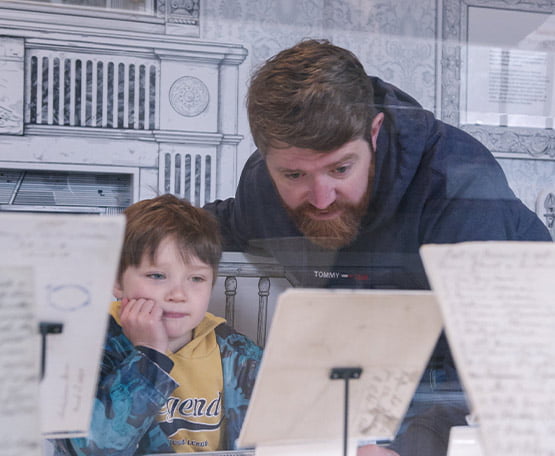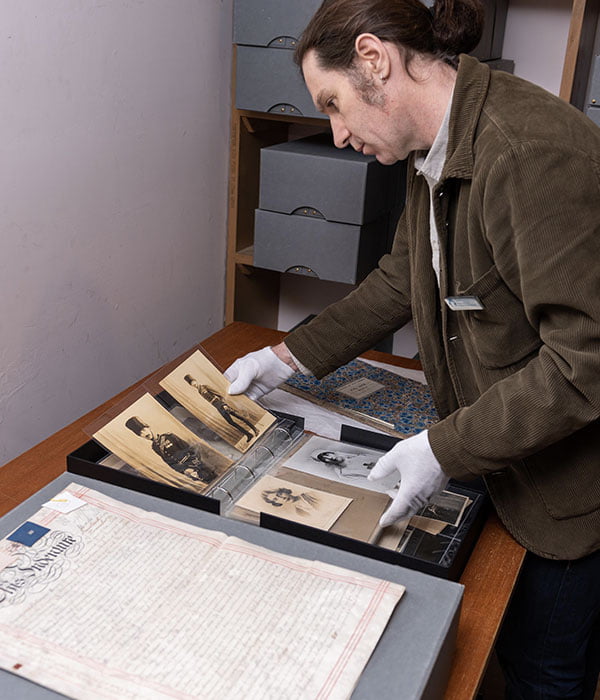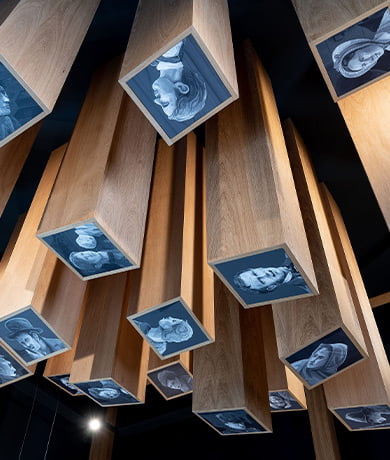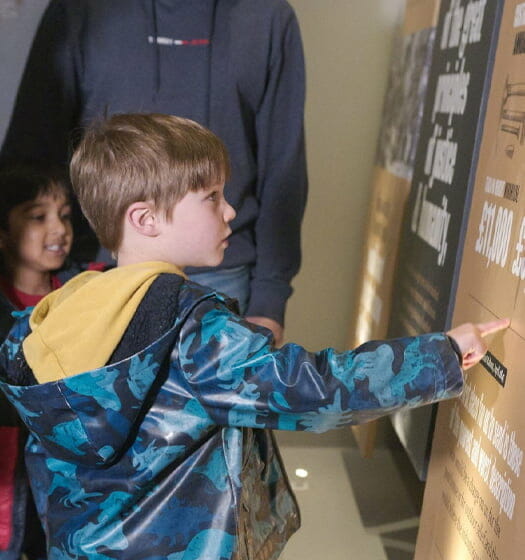Invitation to become a Philanthropic Leader
Regular Giving is all about sustainability. Predictable and reliable philanthropic support enables the National Famine Museum | Strokestown Park to plan and undertake hugely impactful and essential heritage work which would not otherwise happen.
About The National Famine Museum
The Great Irish Famine of the 1840s is considered to be the single greatest social disaster that occurred in 19th-century Europe. Famine had troubled countries across Europe in the 1830s and early 1840s, but – from 1845 – it devastated the island of Ireland. Over 2 million people – almost a quarter of the entire population – either died or emigrated in what became known as ‘An Gorta Mór’: the Great Hunger.
At the National Famine Museum this tragic chapter of Irish history is explored through the prism of dramatically different parallel lives. The Museum, juxtaposed in the shadow of the ‘Big House’, telling the story of those forgotten voices during the Great Irish Famine.


The Strokestown Park Famine Archive
The Strokestown Park Famine Archive is one of the largest and most important collections of documents about the Great Irish Famine in the world and is an extraordinary repository of information about the people, across all walks of life, whose lives – lived in parallel – were irrevocably changed by the famine. It contains thousands of documents, found within Strokestown Park House, that relate to the era of the Great Irish Famine. This extraordinary collection includes unique rental and lease documents, letters and other correspondence, as well as labour and financial records and detailed accounts casting light on the forced emigration scheme from Strokestown. Together, they shed light on the power structures, and the social and political relationships, that shaped 19th-century Irish society and its response to the famine crisis.
At the National Famine Museum this tragic chapter of Irish history is explored through the prism of dramatically different parallel lives. The Museum, juxtaposed in the shadow of the ‘Big House’, telling the story of those forgotten voices during the Great Irish Famine.
Of national and international importance, the Strokestown Park Archive is a complete record of economic, social and estate history and gives a real insight into life on one of Ireland’s great estates. Artefacts and documents from Strokestown’s extensive archive are showcased throughout the National Famine Museum.
The National Famine Museum | Strokestown Park
Sharing & Preserving Our Heritage
The National Famine Museum has recently been transformed with a €5 million investment via Fáilte Ireland and Westward Holdings Ltd in partnership with the Irish Heritage Trust. This investment enables visitors to experience a new state-of-the-art National Famine Museum, telling the complete story of the Great Irish Famine for the first time. Visitors can learn about the political, social, economic, and environmental factors that played a part in the Great Irish Famine and contributed to its devastating human cost.
This new heritage visitor experience not only includes the National Famine Museum, but also the historic walled gardens and woodland walk at Strokestown Park and the Palladian House with its original furnishings and features.
A self-guided audio tour is now on offer, available in six languages, with a mixture of imaginative scene setting and innovative audio-visuals and touch screens. Visitors are able to explore the tenants’ experience of hunger, eviction and exile through voluntary and forced migration while engaging with the landlord’s perspective: his power, his dilemma and controversial assassination and so gain insight into a cataclysmic disaster that changed Ireland forever.
Why We Need Your Support
The National Famine Museum really needs a full time Education Officer to share and engage our global community with their heritage. This person will develop a suite of educational activities, locally, nationally and internationally – both in person and virtually. This post will be endowed in perpetuity to ensure this heritage always retains its voice and presence on the world stage. In particular, the postholder will ensure the newly catalogued famine archive will be open and shared as widely as possible.
To unlock as much of our shared heritage as possible a New Estate Walk is long overdue – via the 17th Century Church, which would add another valued cultural feature at Strokestown for visitors to experience. The new walk will take in the 17th Century Mausoleum, the Icehouse, the Urney 12th Century Church, the c. 2000-year-old tri valet Ringfort and a number of other features. We also wish to undertake a long-held aspiration to investigate the possibilities of an archaeological exploration of the site to access hitherto unknown heritage, all of which will be shared with the public.
To honour the 1490, forced to emigrate from Strokestown in 1847, we wish to commission A Musical Composition for the 1490 – we also wish to create the Great Irish Famine Garden of Remembrance for all victims of the Irish Famine. This will be an area of quiet contemplation and reflection for visitors to pause and connect with their heritage. A New 1490 Memorial is also needed to replace the temporary existing glass wall. This will be a thoughtful, creative, appropriate and artistic interpretation of the wall. It will be of exceptional craftmanship and quality to last in perpetuity.
Support is also needed for the development of the National Famine Way – a unique and historic trail that traces the footsteps of the 1,490 forced famine emigrants who left Strokestown in 1847. Please click here to learn why we need this support.
The National Famine Way is a 165km trail that traces the footsteps of the Strokestown tenants, men, women and children who were marched from Roscommon to Dublin in 1847 after they failed to pay their rent. In Dublin, they boarded a ship to Liverpool before journeying to North America on board some of the worst coffin ships of the time. Not all of them made it alive. They became known as the ‘Missing 1490’.
Your Support
Sadly, there are no funds available for any of these essential next steps. This means The National Famine Museum must now reach out to our community across the world and ask for philanthropic support. To this end, we invite you to become a Philanthropic Leader and join us in securing, protecting, preserving and sharing this heritage in perpetuity, for all.
To achieve these essential steps the National Famine Museum needs to secure at least €6M in philanthropic support.
At the Irish Heritage Trust no donation gets lost in the shuffle. Every single donation helps us in our mission to safeguard and to preserve Irish Heritage – not just for today, but for generations to come.
“This kind of philanthropic support is a salute to the past, an investment in the work that needs to be done today and an eye to the future, where our shared heritage also belongs.”
Anne O’Donoghue, CEO, Irish Heritage Trust
Since 2015 the Irish Heritage Trust, a not-for-profit organisation, cares for and manages the National Famine Museum | Strokestown Park and has overseen this significant redevelopment project. The re-imagined National Famine Museum tells the complete story of the Great Irish Famine in a compelling manner and explores the parallel lives of Strokestown Park’s aristocratic landlords and their tenants during this period. Visitors engage in a truly immersive experience as the Museum takes local and national stories from this tragic period in Ireland’s past and brings them dramatically to life.
If you are interested in becoming a philanthropic supporter of The National Famine Museum | Strokestown Park, please contact us.
Tax Efficient Giving
If you are an Irish taxpayer and donate more than €250 to the Irish Heritage Trust in any year you may increase the value of your gift to the Trust by 44.9%. The Government approved tax back scheme can be availed of by signing and completing the attached CHY3 Enduring Certificate and returning it to the Irish Heritage Trust.
There is no cost to you and the Trust will then reclaim the tax paid on your donation on your behalf from the Revenue Commissioners. All you need to do is to complete the CHY 3 Form and post it to:
Finance Department
Irish Heritage Trust
11 Parnell Square
Dublin 1
D01 ND60
Your Certificate is then valid for 5 years – it can, of course, be cancelled by you at any time.
The impact of this Certificate is considerable and makes a real difference. For example, should you donate €250 the Trust may claim an additional €112.32 in tax back, meaning the true value of your €250 gift is increased to €362.32.
If a company makes a donation of over €250 in the year, the company can claim a tax deduction as if the donation was a trading expense.
There is a four-year time limit for making a claim under this scheme.
Further information from Revenue on the Charitable Donation Scheme can be found here.
The Irish Heritage Trust is an independent registered charity governed by a voluntary Board of Trustees and guided by the Code of Good Practice for Good Governance of Community, Voluntary and Charitable Organisations in Ireland.
Charity Regulatory Authority Number: 20061609
Revenue Charity Number: 16848
VAT Number: 9571484R
Company Registration Office Number: 422959
Contact the Irish Heritage Trust Philanthropy Department
If you would like to talk to us about philanthropy, finance or governance at the Irish Heritage Trust, please contact us below:
Philanthropy
Governance
Daniel Stanford, Deputy Company Secretary
secretary@irishheritagetrust.ie
Finance
Ciaran Griffith, Finance Officer
finance@irisheritagetrust.ie




